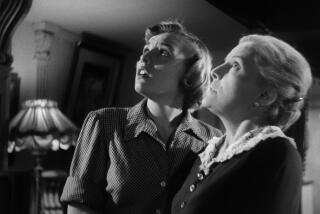An Obsession for Restoring Welles’ Works : Movies: Some of his films have been saved, but others haven’t fared as well. Some were cut by studios; others were damaged or destroyed.
SEVILLE, Spain — Restoring Orson Welles’ films is not a novel idea.
The most recent restoration project is Welles’ “Othello,” which premiered at Cannes in 1952. Intermission Productions began its search for the film’s original elements in 1989, and after restoring both footage and soundtrack, re-released the film last April.
A disastrous preview prompted Welles to cut down his “Macbeth” from its original 107-minutes to 86 minutes for its European release in 1948. The soundtrack was also re-dubbed (to replace the actors lines originally spoken with a Scottish burr). The UCLA Film and Television Archive successfully restored Welles’ “Macbeth” to its original length and soundtrack, and the film was shown at various film festivals throughout 1980.
However, many of Welles’ other films did not enjoy similar fates. Some were chopped down or restructured by the Hollywood studios for commercial reasons; others were damaged or destroyed by neglect.
“The Magnificent Ambersons,” Welles’ critically acclaimed follow-up to “Citizen Kane,” was originally 181 minutes. To the dismay of the director, the film was re-edited to 88 minutes with a new ending shot by a different director for its 1942 release. Searches for the original elements to restore the film to its original form have thus far proven unsuccessful.
In addition, at least six of Welles’ 23 film projects remain unfinished:
In 1942, Welles shot “It’s All True” in Brazil for RKO Radio Pictures. The three-part film was plagued with shooting, budget, location and censorship problems. Studio executives pulled out of the project. The footage was eventually passed on to Desilu Productions and then Paramount; much of it was reportedly destroyed or dumped over the years.
In 1985, a Paramount employee discovered 150,000 feet (almost 30 hours) of the film’s original nitrate negative. The studio retained 5,000 feet of color negative and donated the remaining 145,000 feet of black-and-white negative to the National Center for Film and Video Preservation at the American Film Institute in Los Angeles. The center has deposited its negative at the UCLA Film and Television Archive, which has thus far preserved approximately 25,000 feet.
From 1967 to 1970, principal photography for “The Deep,” with Laurence Harvey and Jeanne Moreau, was completed, but the second-unit underwater photography and actors’ soundtrack were never finished. Welles produced a 40-minute version of “The Merchant of Venice” about the same time, but the soundtrack and a reel of negative were stolen. Yugoslav actress Oja Kodar, who inherited both films, said from her home in Zagreb that that footage is located in a climate-controlled film vault in Los Angeles.
Kodar is also part-owner of “The Other Side of the Wind,” starring John Huston, which Welles shot from 1970 to 1975. The director produced a 2 1/2-hour work print. However, Astrophore Films, an Iranian company based in Paris that had partly financed the film, blocked its completion due to a series of financial and legal problems. Kodar said the negatives and most of the workprints of the film are locked up in a laboratory in Paris, and have not been released by Astrophore Film executives due to their financial demands.
Kodar said Welles was never was able to complete two other projects, “The Dreamers,” based on two stories from Isak Dinesen’s “Seven Gothic Tales,” and “The Magic Show,” shot over more than 10 years and the last scene of which Welles was scripting the evening of his death in October, 1985.
More to Read
Only good movies
Get the Indie Focus newsletter, Mark Olsen's weekly guide to the world of cinema.
You may occasionally receive promotional content from the Los Angeles Times.










